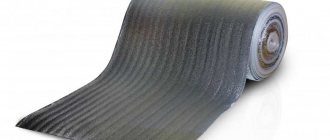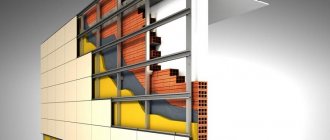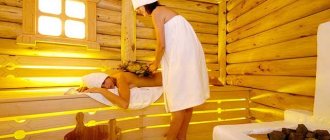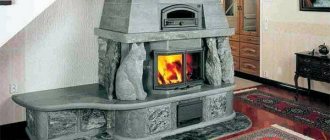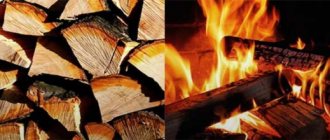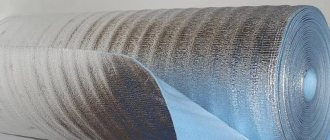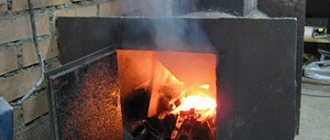Basic rules of insulation: what should you know?
As a result, we will familiarize ourselves with some important rules that everyone should know about.
- The most important rule is that all work should be carried out only after a preliminary calculation of thermal insulation (and based on it). This is explained by the fact that a lot depends on specific factors and characteristics: for example, on the area of the bathhouse, on the number of people for whom it is designed, on the number of rooms and their intended purpose, on the heating system, materials used in construction, etc. .
- The best option is comprehensive insulation, that is, both internal and external. It is better to take care of insulation during the construction of the foundation, walls, and when arranging the roof. Walls, floors, and ceilings are subject to mandatory insulation. For example, the floor in a bathhouse is often a multi-layer structure consisting of solid insulation, a layer of waterproofing, screed and, finally, decorative finishing.
- For walls, a heat insulator, waterproofing and finishing material that partially retains heat are usually used. The ceiling is quite often insulated by arranging a wooden frame, inside of which insulating material is laid.
Foundation thermal insulation
It is more convenient to carry out this procedure during construction, otherwise you will have to destroy the blind area and dig a hole around the structure at least 1 m wide and 30 cm deep. First, a layer of waterproofing is applied to the surface of the foundation, and then insulation boards are glued. This is where foamed polymers will come in very handy - polystyrene foam, or better yet, expanded polystyrene and penoplex. The thickness of the thermal insulation layer in this case will be 50 mm.
Advice. To insulate the base and base of the bathhouse, you should not use various foil insulation materials; they are too thin and will not give the desired effect. Mineral wool is also not suitable, since it is hygroscopic and, after absorbing moisture, is not able to retain heat.
Insulation boards are also laid under the blind area, thus protecting the soil near the building from freezing. Then the concrete blind area is poured and the exterior finishing of the base is done, as shown in the example of insulating a sauna from foam blocks:
The best material for insulating a bath
https://www.youtube.com/watch?v=ycr9ySX8epg
The use of foil insulators is not much different from their simpler counterparts. However, there are some nuances that it is advisable to know.
- To enjoy the original Russian entertainment (we are talking about a steam room), you need to finish the bathhouse completely (floor, walls and ceiling). Even the slightest cracks should not be allowed, because such valuable steam will escape through them in a matter of seconds.
- It is best to fasten the insulator using a construction stapler and glue (obligatory heat-resistant). First we coat the strips and fix them on the surface, and then additionally “shoot” them with staples. This technology provides maximum efficiency. The strips are fixed with the aluminum side up. The sheathing is subsequently installed on it.
If you cannot call yourself an experienced craftsman, opt for self-adhesive models. They are a little more expensive than their simple counterparts, but their installation is much easier.
The peculiarities of bath rooms are that you will need to provide not only high temperature inside, but also create the necessary humidity. For this purpose, multilayer structures made of various materials are used.
To determine which foil to use for a bathhouse is better, you need to take into account what material the structure is built from and the conditions of its operation. If the building is made of logs with carefully caulked walls, then it does not require foil insulation.
In the case where the bathhouse is built of natural wood, but is large in area and does not heat up well, experts recommend lining the ceiling and walls from the inside with thin foil, and then covering it with clapboard. You can use a foil sheet for the surface behind the heating unit, as a result of which the steam room will warm up faster.
Despite the fact that a bathhouse made of foam concrete is considered warm, it requires high-quality vapor barrier, so the use of foil will be justified, but it is better to opt for laminated products.
Frame and brick buildings must be insulated. Insulation for a bathhouse with foil based on polystyrene foam and mineral wool is ideal for this (read: “How to insulate a frame bathhouse - nuances from the master”). The type of this material is selected for ceilings taking into account the thickness of the ceiling and the absence/presence of thermal insulation in the attic.
In addition, operating conditions matter. If the bathhouse is used infrequently and the procedures are not carried out for long, there is no need to insulate it with foil. When the steam room is used frequently and is kept in it for a long time, high-quality thermal insulation will save fuel, and the room will quickly warm up and cool down for a long time.
DIY installation
To install foil insulation we will need the following tools:
- mounting stapler, stationery will not work;
- small nails or dowels;
- nail hammer;
- the insulation itself;
- for sealing joints, foil tape.
As you can see, to install insulation you need a minimum set of tools, which can be found in almost every owner. Before you begin, you should know which side to apply the material to the wall.
To retain heat inside the bathhouse, the reflective surface of the insulation must be indoors. You should also know that there must be a gap between the material and the finish, which will create an air cushion that will help in additional heat retention.
Before you begin installing the insulation, you need to calculate what pieces to cut it into. In the case of the roll type of material, the principle of gluing wallpaper works: unfold, measure, cut and attach. The only difference from the latter is that the insulation is attached with nails, and not glued. After the piece is applied to the wall, it is nailed along the entire perimeter. I would like to note one nuance: the insulation should be attached joint to joint, in no case overlapping. And each joint is carefully taped with foil tape. All this allows you to most effectively prevent heat loss.
Installation of foil insulation
In order for the bathhouse to have a finished and beautiful appearance, it is necessary to fill the lining on top of the insulation; this must be done in such a way as to create an air gap between the insulation and the outer wall cladding. You need to go through every centimeter of not only the walls, but also the doors; you shouldn’t give even the slightest chance of losing precious heat. To do this, horizontal strips are placed at equal distances along the entire perimeter of the wall. The lining is assembled onto these strips.
Layout of the lining
The insulation of the walls can be considered complete. Foil insulation is the most effective way to retain heat in a steam room by preventing it from cooling quickly. In addition, retaining heat helps save a lot of energy, because the bathhouse will have to be heated less often. For this reason, you should not save on material; in the future, the price of high-quality insulation will be able to pay off.
Product range of possible foil insulating products
Knowing the basic requirements for foil materials, you should consider in detail the types of thermal insulation products. Finishing a bathhouse with foil will take less time if you study all the diversity of the insulation market in advance. Below is a list of the most common ones:
Aluminum foil for the bath. This thermal insulation product is sold in rolls. Rolls in the markets are presented in a wide range. Rolls can be of different widths and lengths. The thickness of the layer can also be different.
Foil in rolls does not have a base. Used for installation on top of an existing mineral insulator. You can use aluminum foil for a bath up to 650 degrees
The owner himself can choose the thickness of the thermal insulation; it is important to remember that the final strength depends on this. The reflectivity of aluminum sheet is usually at least 95%
Installation is carried out with an overlap, with mandatory gluing of the joints with metallized tape. The use of foil for insulation is absolutely safe for human health, since it does not emit toxic substances when heated.
Kraft foil. This thermal insulation material is made on the basis of cellulose; it can also be found in a three-layer design consisting of foil, polyethylene and kraft paper.
The main properties include high strength, environmental friendliness, and tightness. Kraft foil has a small thickness, which may not exceed 1mm. The surface of the foil has a reflectivity of 95%. Despite the fact that the operating temperature of kraft foil is noticeably lower than that of rolled aluminum sheets, and is only 100 degrees, it is much more convenient to install, since it is less susceptible to mechanical damage and has greater flexibility.
"Folgoizolon". Baths whose walls are lined with this material, if all technology requirements are met, do not require additional insulation measures. In addition to all the main functions, Folgoizolon has soundproofing properties. This product is usually sold in rolls, but you can also find sheet packaging when it is thick. Its base is foamed polyethylene.
In sheets, "Folgoizolon" has standard dimensions of 600 * 1200 mm with a thickness from 20 to 110 mm. In rolls, the thickness does not exceed 10 mm with a width of 1000 to 1200 mm.
“Folgoizolon” is easy to process during installation, it is not subject to deformation, and can withstand temperatures up to 125 degrees in operation.
The most popular thermal insulation product on the Russian market is foiled mineral wool. Products based on mineral raw materials have traditionally been used in insulating any premises for many years. In the markets it can be purchased both in rolls and sheets, with a thickness from 30mm to 100mm. The main disadvantage is the presence of an unpleasant installation procedure. Cheap thermal insulation causes irritant reactions in human mucous membranes.
"Penofol". For a bathhouse, this foil thermal insulation can be an excellent product with vapor barrier properties. Being a vapor barrier-based fabric, Penofol not only does not let heat out, but also helps the walls to “breathe.” The reflectivity of the material is about 97%. With such indicators, we can safely say that the thermal insulation of bathhouse walls using Penofol will be better. The thickness of the main heat-insulating layer, as a rule, does not exceed 10 mm. The vapor barrier material can withstand temperatures up to 300 degrees.
Performance characteristics by type
Manufacturers offer sauna foil in different designs. This determines their geometric parameters and operational characteristics. We invite you to get acquainted with the main varieties and their features to make it easier to make an informed choice.
Foil comes in different types PHOTO: zharpar.rf
Rolled foil
This material is produced in sheets and rolls. The thickness of the rolled material is 0.007 - 0.2 with a width of 0.01 -1.5 m. For bath insulation, materials with a thickness of 30 - 100 microns are mainly used. Contains about 99.5% aluminum. Depending on the design, the surface of the rolled foil can be:
- smooth, not requiring additional finishing;
- for finishing. After insulation, finishing material is attached to the surface;
- finishing
Rolled foil has different thicknesses and widths PHOTO: i0.wp.com
Paper-based foil and foil fabric
Paper-based foil is often called foil or laminated. The material has sufficient elasticity, optimal density and excellent vapor barrier properties. Manufacturers offer two types: based on kraft paper and paper with polyethylene. This insulation:
- able to withstand heat of +130ºС, which is especially important for a bathhouse;
- resists compression load well;
- keeps its shape;
- easy to cut;
- Allows various mounting methods. It is possible to use nails, staples, screws;
- installed inside the bathhouse.
The paper base provides elasticity PHOTO: bannydvor.com
Foil fabric consists of two layers: foil and fabric. It has a thickness of about 0.12 - 3 mm. The sheets in the bathhouse are attached end-to-end. The material can be used to cover walls adjacent to the heating unit. Such material for a bath:
- able to withstand heating up to 500ºС;
- resistant to mold and harmful microorganisms;
- has good moisture resistance.
Foil fabric is the best solution for a bath PHOTO: i.sunhome.ru
Foiled polystyrene foam and polyethylene foam
The basis of foiled polystyrene foam is polystyrene foam, onto which a thin layer of aluminum foil is applied during the manufacturing process. Supplied in sheets measuring 1.2 x 0.6 m. It can have a thickness of 2 – 10 cm. The presence of stepped locks helps prevent the appearance of cold bridges. Foiled polystyrene foam is safe for health. Does not absorb moisture. This bath material has:
- reflection of up to 98% of heat;
- good vapor barrier properties;
- chemical resistance;
- long service life.
Foligron polystyrene foam is capable of reflecting a large percentage of heat PHOTO: pol-exp.com
Foil polyethylene foam for baths has a thickness of 2–10 cm. The foil can be attached on one or both sides. It is actively used in arranging the interior of a bathhouse. It can heat up to a temperature of no more than 100ºС, which precludes its use for covering the surface adjacent to the furnace.
The thickness of foil polystyrene foam is selected individually PHOTO: avatars.mds.yandex.net
Foil mineral wool in rolls and mats
Foil mineral wool is supplied in mats and rolls. May have different thickness. Has good thermal insulation characteristics. Can be used for insulation of frame baths. The convenient release form greatly simplifies installation work.
Foil-coated mineral wool is in demand when insulating a bathhouse PHOTO: vosaduly.ru
Insulation materials
Thermal insulation of the steam room is carried out using a variety of materials, ranging from ultra-modern to time-tested. And we will begin our analysis of the characteristics with, perhaps, the most used, but rather outdated material - mineral wool.
Mineral wool
As mentioned above, this material has been known for quite a long time and many experts classify mineral wool as obsolete. Nevertheless, in terms of its thermal insulation characteristics, it is hardly inferior to modern insulation materials. However, this material is quite expensive and is very susceptible to moisture. When wet, mineral wool loses its thermal insulation properties and begins to rot, transferring this process to adjacent wooden structures. In this case, the steam room will have to be insulated anew.
To prevent this from happening, when insulating the steam room from the inside with mineral wool, you should take care of high-quality and reliable hydro- and vapor barrier insulation of all surfaces insulated with mineral wool, that is, walls and ceilings, with foil vapor and water insulators. Vapor barrier of a steam room is very, very important, since with properly performed vapor and waterproofing, mineral wool can last a long time without losing its thermal insulation qualities. It is quite possible to replace mineral wool with stone or glass wool.
Now we will briefly consider one of the most modern thermal insulators for steam rooms - polystyrene foam and how to insulate a steam room in a bathhouse with this material.
Expanded polystyrene
Why will we write briefly about this material? Yes, because it is not entirely suitable for insulating a steam room in a bathhouse. Although its thermal insulation properties are very, very high, it is not afraid of moisture and rodents and mold do not like it, all these advantages disappear when you find out its other side.
Even though polystyrene foam does not burn, it begins to melt at high temperatures. And everything would be fine. But! When melted, this heat insulator releases toxic substances, which can lead to poisoning. And although many still use it, when answering the question of whether it is possible to use polystyrene foam as insulation for a steam room, we strongly advise against doing so.
Let's move on, in fact, to insulating the steam room from the inside, step-by-step instructions for what follows.
Natural
Natural or natural insulation materials have found wide application in improving the thermal insulation of bath structures. Since ancient times, people have used felt, flax tow and moss as inter-crown heat-insulating material. These products are valuable because they provide natural air exchange. In addition, natural heat insulators have bactericidal properties and practically do not rot.
Other advantages of natural raw materials include:
- environmental cleanliness and harmlessness to human health;
- long service life;
- low cost;
- low thermal conductivity.
However, natural insulation materials are not without their drawbacks. Their main disadvantage is flammability. Of course, the material can be pre-treated with fire-resistant compounds before installation, but because of this, the raw materials will not be completely environmentally friendly.
Another disadvantage is the high risk of damage to the heat insulator by rodents and birds. Natural materials can harbor insects that can “negate” the thermal insulation properties of the insulation. Also, some of the materials may cause serious allergic reactions.
Aluminum foil: another scam by manufacturers?
Aluminum foil for bath insulation is a thin (on average 30-300 microns) layer of aluminum, which is used unchanged or in combination with kraft paper, fiberglass, or roll insulation. The main argument of opponents of using foil in a bath is that aluminum has high thermal conductivity.
Based on this, thermal energy can easily pass through the metal layer and end up outside the steam room. In fact, everything is not quite like that. Firstly, high thermal conductivity will “work” against us only in the case of direct contact of the foil with a heated body (for example, with a wooden paneling or blockhouse). Secondly, in addition to thermal conductivity, there are other methods of heat transfer.
Rolled aluminum foil
Foil is produced in both rolls and sheets. Roll material can have a thickness from 0.007 to 0.2 millimeters, a width of 10–1500 millimeters. The percentage of aluminum content in it is up to 99.5%.
Depending on the type of surface, foil is:
- smooth, without additional finishing;
- for finishing;
- finishing
Depending on the manufacturing method, foil is distinguished:
- soft (annealed), marked “M”;
- solid (unannealed) – it is assigned the letter “T”.
Thin fabric is wound on bushings having different diameters. Thick foil is produced in sheets.
Before starting insulation work, developers are interested in how much foil for a bathhouse costs. Domestic roll products will cost less than imported material. With a roll length of 25-30 meters, the price will be approximately 20-30 dollars.
Photo of a roll of foil
For high-quality thermal insulation of the steam room, the insulation material must have increased water resistance and fire resistance.
Foil for baths and saunas is ideal for these parameters.
Characteristics
- There is no effect of deformation at high temperatures.
- Aluminum does not emit fumes harmful to humans.
- High level of vapor barrier. Thanks to this, hot steam does not escape from the room, but fulfills its purpose.
The steam must remain inside to achieve the correct effect
No steam accumulation in the material itself. This significantly increases the service life. Acceptable price. No condensation on the walls
This is especially important in the case of wooden walls. Since the presence of condensation can lead to the appearance of mold and rotting processes. Insulating the material from the harmful effects of excessive humidity and other possible effects
This extends the life of the building itself. Heat reflection effect. The aluminum surface reflects thermal radiation, which significantly speeds up the heating of the steam room, which allows you to save on heating costs. Easy to install. Affordable DIY implementation. Durability. Does not rust, does not rot, and is not attacked by pests.
Which foil is best for a bath?
Let's look at its most prominent representatives:
Folgoizolon for baths is polyethylene coated with aluminum foil. To all of the above qualities, a high level of noise insulation is added and increases strength. And heat conservation is carried out not only due to reflective properties, but also by reducing thermal conductivity.
Folgoizolon sheet
Paper-based foil for baths significantly increases the strength and reliability of the product and is an environmentally friendly material.
Extra layer of paper for added durability
Foil insulation for a bathhouse is any classic insulation material, such as isolon or even mineral wool, in which one of the sides is covered with a layer of foil to increase waterproofing, fire safety and protection from the aggressive environment of the steam room. The cost increases accordingly depending on the combined insulation.
Roll of foiled mineral wool
Thus, all varieties simply involve adding an additional layer, which adds some quality, but also increases the cost. In order to save money, regular bath foil is suitable, as it already has a sufficient number of necessary qualities.
Installation
The following instructions will help you install the foil:
- We buy a sufficient amount of foil with a thickness of 100 microns.
- We fix the foil to the boards using a stapler, furniture nails or tacks. At the same time, we make overlaps of several centimeters.
- We fasten the aluminum strips together with mounting tape.
Connect with construction tape
The process of strengthening the sheathing strips
We install the inner finishing layer.
It should be noted that when using an additional insulating layer, it is installed in front of the foil.
For example, if it is mineral wool, then we do the following:
- We nail wooden blocks with a cross section of 5 cm by 5 cm onto the walls and ceiling of the steam room. In this case, we keep the distance between them equal to the width of the insulation boards.
- We put insulating material between them.
- The above installation steps follow with one clarification: the foil is fixed to the intermediate strips.
Foil over mineral wool
If you use bath insulation with foil, the covering process is even simplified and becomes more cost-effective than purchasing and installing them separately.
Application of foil vapor barrier
Izolon
If you decide to use such material when building a bathhouse on your summer cottage, this does not mean at all that you need to incur significant expenses. You don't need to invest a lot of money to insulate the entire building. The optimal solution is installation exclusively in the steam room and shower room. The foil layer effectively accumulates heat, and the polymer inside reliably protects the structure from moisture and steam. For other rooms, you can simply purchase simpler and cheaper material.
In addition to insulating the walls, foil material must also be installed on the ceiling, under which hot air and steam collect in the steam room. It is advisable not to forget to use it on doors. But it’s not worth laying any foil insulation on the floor, since its construction here usually consists of a concrete screed with a wooden deck on top. The exception here is warm water floors.
Types of suitable insulation materials
In our opinion, it makes sense to divide the types of thermal insulation materials for baths into sheet, roll and backfill. In addition, there are insulation materials that are applied to the walls in the form of foam or a moistened mass - these are polyurethane foam and ecowool, which are sprayed using special equipment.
Mineral wool can be purchased in rolls or sheets. It all depends on its density and the binders used.
BY THE WAY! We rarely name specific brands, but do you understand that the names Rockwool or Isover hide the same mineral wool produced by different companies?
Basalt wool is a type of mineral wool, a literal reference to the similar mineral used. There is practically no difference.
Basalt wool for baths
But you shouldn’t confuse mineral wool and glass wool - these are different insulation materials, made from different materials and with different properties.
Glass wool should no longer be used anywhere, because it is extremely unpleasant for humans - if it gets on the skin, it causes itching, and it is hazardous to health if it gets into the eyes or respiratory organs. Yes, and fiberglass crumbles during operation, turns into dust, and it penetrates through the cracks, and you breathe it.
Does not like fiberglass insulation and elevated temperatures typical of a bathhouse.
Polystyrene foam and extruded polystyrene foam are good insulation materials, especially the latter, but using them in a bathhouse is dangerous. They are absolutely not suitable for a steam room, but could (theoretically) be used in other rooms, but we will not recommend them, since they are a fire hazard.
ADVICE! In the bathhouse, polystyrene foam and penoplex can be used in floors under concrete screed - there they do not pose any danger.
So, sheet insulation is mineral wool, foam glass (excellent, but expensive insulation), calcium silicate and magnesium silicate sheets, non-recommended polystyrene foam and extruded polystyrene.
Foam glass
Roll insulation is again mineral wool (lower density), glass wool. foamed polyethylene, with or without foil (penofol, isolon, etc.).
We have already spoken about fiberglass, now about foamed polyethylene. It is often used as additional insulation in residential buildings, but polyethylene does not tolerate high temperatures, so it should not be used instead of foil to insulate a steam room.
Foil insulation Penofol
IMPORTANT! Polyethylene already melts at a temperature of one hundred degrees. By the way, it supports combustion.. In general, it is quite possible to insulate other rooms of the bathhouse with it (as a second layer)
In general, it is quite possible to insulate other rooms of the bathhouse with it (as a second layer).
We will divide bulk insulation for baths into those that can be moistened and “glued” to the wall, and those that cannot. Expanded clay and vermiculite belong to the second category, ecowool - to the first.
Expanded clay and vermiculite can be used to insulate floors and ceilings, where they adhere perfectly and retain heat indoors. In order to insulate the walls of a bathhouse with them, it is necessary that between the two layers of the main wall material there is a gap, a cavity that can be filled with insulation.
Expanded clay
Ecowool is waste paper (cellulose) crushed into dust, impregnated with fire retardants so that it does not support combustion. And it really doesn’t support it - this is a good material for insulating baths where it is on sale. Ecowool is used in dry and wet form. In dry conditions - for insulating floors and ceilings, as well as for filling cavities. When wet - for application to walls.
Insulating the roof with ecowool using the wet method. Cromwell Photos
Also on our website you can read two articles that provide a more complete overview of insulation materials that can be used in a bathhouse:
- review of bath insulation;
- choosing the best of natural and artificial insulation for a bath.
Which method to choose for insulation inside and outside the room?
The choice of insulation method is influenced by what is located above the ceiling - a cold attic, a residential attic or a flat roof with a low slope, which leaves minimal attic space. In total, there are only three methods for arranging the ceiling:
- grazing;
- hemmed;
- panel.
Flat ceiling insulated with expanded clay, clay and sawdust
For those who have an attic, but do not want to turn it into a warm warehouse or recreation room, the design of a flat ceiling is suitable. It is considered the simplest, since you are not supposed to walk in the attic, which means there is no need even for floor beams. The rough ceiling is placed on the frame of the building, that is, directly on the walls.
Important! There are limitations associated with this. The boards will withstand a layer of insulation if their length is no more than 2.5 m with a board thickness of 4–5 cm.
Different materials can be used, but the structure of the “pie” is the same in any case. It consists of layers (from top to bottom):
- insulation;
- wax paper;
- boards;
- vapor barriers;
- finished ceiling.
The layout of a flat ceiling with insulation is very simple
The vapor barrier material must not only be hydrophobic, but also withstand high temperatures, so its choice is limited. Most often, foil is used as a vapor barrier. The last layer is made of expanded clay (slag) or clay with straw.
In the first case, expanded clay is poured in a layer of 20 to 30 cm onto a layer of waxed paper (so that it does not spill through the cracks). This thickness is enough for the thermal insulation properties of this material to manifest themselves. Expanded clay fractions should be taken different so that the small ones fill the voids between the large ones.
Often, before filling, divider boards are placed on the rough ceiling from the attic side.
The appearance of a flat ceiling insulated with clay is no worse than when using modern materials
The main advantages of the material
The high popularity of foil insulation for baths is due to an impressive list of its advantages:
The so-called “thermos effect” is created, that is, when heat does not escape from the room at all. This type of insulation is simply ideal for baths and saunas, as it allows you to preserve precious steam as reliably as possible.
Tip: Effective thermal insulation will significantly reduce energy costs. As a result, the bath will warm up much faster.
This insulation provides excellent protection against moisture and vapors. Therefore, there is no need to create a water-repellent layer
This is extremely important for wooden buildings. One of the main features is absolute resistance to temperature changes. They are achieved thanks to the presence of a heat-repellent layer
Simple roll insulation materials will only last a few years when used in such conditions. Reducing the thickness of the required insulation layer. This property is achieved through the use of special foil, which increases the efficiency of thermal insulation. Increasing the noise insulation properties of the room. Absolute environmental cleanliness. High hygiene is an important factor for premises of this kind. Very light weight (except for mineral wool). This makes installation and transportation easier. In addition, there is no need to build a frame (in most cases this is the most labor-intensive procedure).
Please note that a similar group of materials is used in many other areas (from apartment buildings to car showrooms). It is perfect for use in conditions of high humidity and sudden temperature fluctuations.
When arranging a steam room, you should be especially careful when deciding which foil is best for a bath, since the material must be environmentally friendly and reflect heat well. All these requirements are met by insulation materials with aluminum foil coating.
Advantages of foil insulation:
- The material is universal because it is used for walls, ceilings and bath floors.
- Insulation with foil coating has good light reflection.
- Products are produced in a wide range.
- They are used in damp areas and do not require treatment with fungicidal compounds.
- They have high hygienic indicators. The properties inherent in aluminum do not create a breeding ground for the growth of fungus and mold.
- They do not deform and do not melt in the steam room at elevated temperatures.
- The material is convenient to work with. It is easy to mount and fix on different planes: vertical, horizontal and inclined.
Tips for insulating baths:
- If the bathhouse building does not have a commercial purpose, finishing the walls with 3 mm foil in rolls will be sufficient.
- For commercial enterprises, the solution to the problem of which foil to choose for a bath is the use of laminated products on a basalt mineral base.
When insulating a bathhouse located inside a permanent building, you need to take into account the functioning of central heating, since it additionally heats the air.
Classification of foil: types and properties
To select the optimal model, it is necessary to determine the functional purpose of the foil layer. In a steam room, it can serve as a reflection of thermal energy. But for this, the material should not be closed, otherwise the meaning of its use is lost. Also, a layer of foil can be installed in the area of the heater to maximize the concentration of thermal radiation into the room.
When arranging a bathhouse yourself, it is recommended to use aluminum foil with a backing. This will reduce installation time and labor intensity. This approach is due to the relative fragility of foil materials - even a slight excess of mechanical stress can cause the layer to rupture.
Roll without base
The best option for improving the thermal insulation qualities of the steam room. The material is a roll of aluminum foil, up to 250 microns thick. Length varies from 5 to 20 meters, width – up to 1500 mm. The maximum temperature limit for this material is +650°C.
Features of installation and operation:
- rolls are mounted overlapping;
- special foil tape is used for fixation;
- the material must fit tightly to the insulation;
- installing two or more layers does not make sense, since it will not affect the increase in heat-reflecting properties.
The average cost of 1 m² is 48 rubles.
Reinforced foil
It is necessary for arranging walls, ceilings and floors with a complex configuration with many indirect elements and angles. Unlike conventional rolled material, reinforced foil has an additional layer of fiberglass mesh. It increases the mechanical strength of the reflective surface.
- some models have an adhesive backing to simplify installation;
- joining several sheets is also done using tape;
- You can purchase rolls with one-sided or double-sided foil coating;
- Roll length up to 50 m, width 100 cm.
Despite all the advantages of the reinforced model, it is rarely used for arranging a bathhouse. This is due to the high cost - from 150 rubles per 1 m².
Kraft foil
To improve mechanical strength and durability, a new type of heat-reflective material was developed that combines a base of impregnated paper and aluminum foil. In fact, it is an insulation material that combines the properties of cellulose to retain heat and reflect IR radiation.
To increase safety, the paper is impregnated with fire retardants. In addition, the material has the following properties:
- Possibility of installation directly on the inside of a wooden wall;
- the small thickness will not affect the reduction in the useful volume of the steam room;
- increasing tensile strength.
The average cost of kraft foil is 110 rubles per 1 m².
With thermal insulation materials
To fully insulate a bathhouse, it is recommended to use heat insulators, one of the sides of which is foil-coated. The reflective layer is applied to the adhesive base, this increases the strength characteristics of the foil and allows you to create reliable thermal insulation.
The following are used as insulation:
- Basalt (stone) wool. The best option for a bath or sauna. It is heat-resistant, its structure allows moisture to pass through, which is a prerequisite for a steam room.
- Foamed polyethylene. It has increased flexibility and is waterproof.
- Extruded polystyrene foam or polystyrene foam. Budget options for insulating a bath.
The presence of a layer of foil does not greatly affect the cost of these heat insulators.
For a bathhouse, it is better to choose insulation with a foil side. This will reduce labor costs and allow you to maintain the required microclimate characteristics in the room.
When building a bathhouse, the main task is to create a structure that will quickly warm up and retain heat for as long as possible. For this purpose, the walls and ceiling are insulated. Aluminum foil for baths is most often used as insulation. There are several types of this material, differing in strength, ease of installation, durability and service life. When choosing a specific type of foil insulation, you need to focus on the characteristics of the building.
Peculiarities
A homogeneous wall in any building does not retain heat well, since it itself is capable of absorbing part of the thermal energy. To reduce heat loss, civil engineers began to create multilayer structures consisting not of one, but of several materials that differ in density, porosity and other indicators. Multilayer walls are able to “maintain” the temperature for a long time.
To create such a structure, you cannot do without insulation. The correct choice and error-free installation of thermal insulation materials from the inside of a bathhouse or sauna will reduce heat loss and reduce fuel consumption. You should know that not every insulation material is suitable for insulating a steam room. The best solution would be environmentally friendly products that are resistant to high humidity and have bactericidal properties (preventing the formation and proliferation of mold).
The thermal insulation materials used must have the following properties:
- Low thermal conductivity. The effectiveness of the material directly depends on this parameter.
- Ability not to deform during long-term use.
- “Combination” with previously selected building and facing materials.
- The presence of minimum moisture absorption indicators.
- Compliance with sanitary and hygienic requirements and fire safety standards.
Purpose of the foil layer for a bath
When insulating a bath, foil can perform various functions. It is used as an independent reflective heat insulator or as one of the layers of a heat-insulating cake. By placing foil between the lining and a layer of thermal insulation, it is possible to create the effect of a thermos. This is the best option for a brick, concrete or frame structure.
If the foil is used alone, it acts solely as a reflector or vapor barrier, protecting vulnerable materials from moisture. With its help, it is possible to increase the air temperature in a small steam room and protect the walls of the bathhouse adjacent to the stove from possible fire.
Foil in a bath can be used in different ways PHOTO: 1.bp.blogspot.com
Date: September 25, 2022
Walls
Insulation of walls begins with the installation of wooden frame racks. is installed in the resulting cells tightly, spaced apart, without any gaps, to prevent the occurrence of “cold bridges”. To achieve greater effect, it is recommended to lay the slabs in two layers with the joints overlapping as much as possible.
Vapor barrier
Protection of cotton wool from moisture is carried out using a vapor barrier. To achieve the required effect, the barrier must be continuous.
The rolls are rolled out over the entire surface of the walls with an overlap of 10 - 15 cm. You should start from the bottom. The first roll is rolled out close to the floor with a slight overlap on it.
The vapor barrier is attached to the frame elements using a construction stapler. The joints are sealed with metallized aluminum tape.
